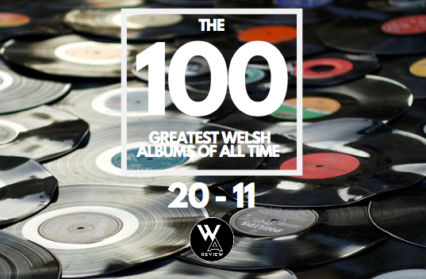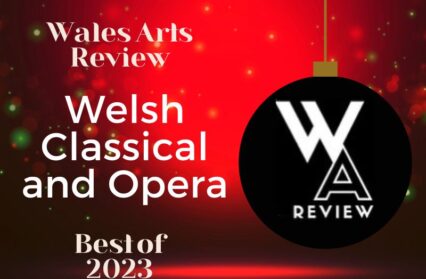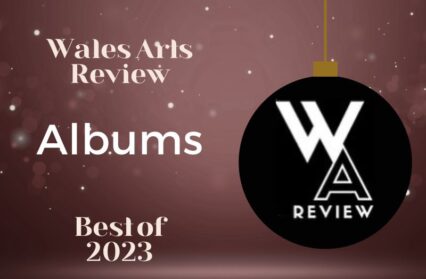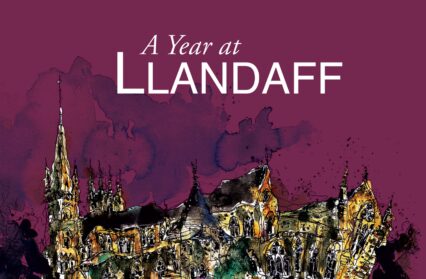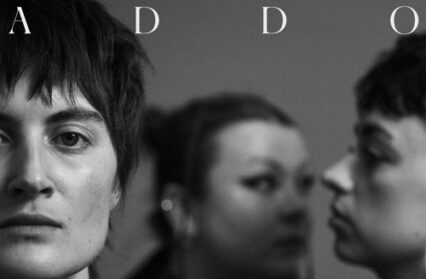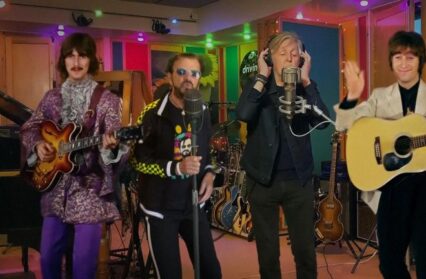Join Wales Arts Review every Friday as we count down the one hundred greatest Welsh albums of all time, as chosen by the Wales Arts Review team and friends of the Review. Hold onto your hats! It’s week nine, the penultimate in the series, counting down from 20 -11 of the greatest Welsh albums, from music released this year to music released decades ago, we’re taking in everything from indie-pop, psych-folk and dance electro to chamber pop, techno and hip-hop.
20
Super Furry Animals
Fuzzy Logic
(1996, Creation)
Released at the apex of the ‘90s Britpop reign, SFAs’ debut album reacted against (what Gruff Rhys later dubbed) a “conservative backwards movement in music” – and did so with a rampaging kaleidoscope of shimmering sounds (from gonzo glam-rock to electro-psych to synth-pop-laced-rock to some barrage of all those sonic areas and more – fused, crossed, recrossed, split and ultimately stitched back together). Opener ‘God! Show Me Magic’ is an assaulting and compelling true-boogie hit that gets you right between the eyes. Fuzzy Logic is, indeed, fuzzy – and across the course of its neo-psychedelia sounds and lyrical trips tackling hamsters, unicorns and drug lords, it feels nigh on impossible not to be drawn in by this album’s restless and consuming brand of mischief. From the heavy influence of Howard Marks felt throughout the length and breadth of the record (and on its cover) to the Beach Boy-esque melodies which would endure for many albums to come, what critics felt Fuzzy Logic lacked in consistency, it made up for in pure, outlandish, high-grade fun. Adventuring, ridiculous and – dare I say it? – timeless. Where would any greatest Welsh albums list be without it?
19
Audiobooks
Astro Tough
(2021, Heavenly Recordings)
This audacious follow up to 2018’s Now! (in a minute) showcases a sharper vision from super producer and multi instrumentalist David Wrench and his partner in crime artist and model (and now definitely writer) Evangeline Ling. Ling’s deadpan delivery of her caustic, empathetic, often hilarious lyrics are now front and centre rather than part of the jagged experimental landscapes of Wrench’s world. This alone makes for a step in the right direction from their brilliant-enough debut. Astro Tough never misses a beat, and is frequently as good as thoughtful, soulful, dance music can get. It’s a paean to club culture for the most part, but also there are sweeping moments of acoustic psychedelia and even a bit of 80s naval-gazing indy-pop in there. Ling now brings to mind such unshakably radical vocalists as Ari Up, Sarah Nixey, and Sue Tompkins, and her story-telling is now as assured and incisive as an Amy Hempel or a Claire-Louise Bennett. Wrench gives bedding to these winding parades through the anxieties, disappointments and idiosyncrasies of the modern life of a young woman such thudding, melodic, backbeats the juxtaposition of music and lyric is sometimes unbearably poignant, unbearably arresting, and unbearably cool. This is an album that will surely grow in stature as its treasures are more widely discovered. And it deserves to be heavily weighed down with awards and accolades in the next year or so.
18
Gwenno
Le Kov
(2018, Heavenly Recordings)
Music has always impacted us humans – and cool music, especially, has the power to inspire everything from peculiar dress sense to impassioned cult-like followings. In the case of Gwenno’s euphoric, critically acclaimed hit Le Kov, the record would go on to be credited by Cornwall’s Language Board for a record uptake of the Cornish language exam in 2018. That is to say, this is not your everyday record – and the ethereal, twinkling, swirls of its soundscape are certainly compelling enough to make you wish to submerge yourself in its world more completely. For most listeners of Le Kov – a name which translates to ‘A Place of Memory’ in English – it is the deliciously folkloric sound of psychedelic beats and intricate drumming patterns which draws one into this record’s luminescent world. For English speakers, the soft cadences of Gwenno’s Cornish lyrics might predominantly serve to heighten the sense of transcendental magic, but on inspection – and translation – there is here a rich and beautiful catalogue of lyrics which contemplate everything from a post-Brexit Cornwall to a love story with a computer. Best of all, of course, is the addictive fourth track ‘Eus Keus?’; between its refracting chorus of diaphanous colour and light and its commanding spoken-word chorus, is a question of ever relatable and crucial importance: “Is there cheese?”
17
Group Listening
Clarinet & Piano: Selected Works, Vol. 1
(2018, Prah Recordings)
This collection of ambient instrumental workings of music from a range of songwriters and composers plus additional field recordings was released quietly, but the underappreciated gem never fails to delight three years on. Group Listening are Sweet Baboo mainstay Stephen Black, seen more recently playing bass for Gruff Rhys and Cate Le Bon, and experimental jazz musician Paul Jones. Playing clarinet and piano/keyboard respectively, the duo created a record both charming and thoughtful, exploring a wide palette of songs from Brian Eno, Robert Wyatt and more. Raymond Scott’s Happy Whistler originally composed to soothe fretting young children is delightful and cheery when given the Group Listening treatment. On Euros Childs’ The Dog a simple piano replaces Childs’ original buzzy keys but still retains that hymnal sense of calm. Group Listening have a new record – somewhat logically named Vol 2 – due in 2022.
16
Meilyr Jones
2013
(2016, Moshi Moshi)
Inspired by a Roman sojourn in the year that gives the album its title, Meilyr Jones’s solo debut album is an ostentatious, coruscating record which is, in many ways, still peerless in the sheltered predictability of the indie-sphere. 2013 is not only bold, it is oxymoronic – somehow discordant and harmonious at the same time – knitting together seemingly unrelated sonic scraps and making them a cohesive part of a panoramic whole. Its sound is baroque, orchestra-led, mingling the operatic with the everyday. Here’s a 30-piece orchestra, here’s a birdsong; here’s a heavenly choir, here’s a busker’s accordion. The texture of Jones’ field recordings, dispersed throughout the album, capture real snippets of his stint in Rome. It is these samplings which make 2013 not just a musical palimpsest for a lapsed holiday, but a tangible vehicle for lived memories – like crumpled train tickets and dried flowers pasted into the pages of a travel journal. The first track from 2013 – ‘How To Recognise a Work of Art’ – is not only a brass-beat pop-bop, it is plied with questions of authenticity. It’s a fun song, and lyrically obscure, the overall message – if anything – seems to be that we should all lighten up a bit. It’s a sentiment echoed with more severity on the following track, ‘Don Juan’, where Jones sings: ‘There’s a band on the radio singing politely’. Simple yet cutting, it’s an observation which may well be aimed less at a particular artist and more at the musical bubble of Radio 6, where, at times, even the eclectic can begin to feel predictable. Set to a Medieval-esque cacophony of harpsichord and piano, it certainly sounds esoteric. 2013 – with its expansiveness, its drama, and its strangeness – is a rejection of modern indie lore.
15
Manic Street Preachers
Generation Terrorists
(1992, Sony Music)
When Generation Terrorists was released in early 1992 it confused and confounded, as the band had no doubt hoped that it would, but possibly not in the way that they’d initially intended. The much-touted aim to sell 16 million copies of this, their debut album (a double album, no less) and then split up in a blaze of wanton self-destructive glory convinced no-one, least of all the band themselves, of the true nature of their master-plan of cultural entryism. Yet to those who had only ever viewed the band as nihilistic punk rock outlaws the slick big-budget transformation of the intense syntax-mangling songs that had previously only been heard on the tinny in-house sound systems of the likes of the Bristol Fleece and Firkin seemed a world away from the breathless heart-bursting rage of their initial Heavenly singles. Though with hindsight, the band now regrets the thick layers of industrial major-label polish that was liberally applied to its raw material, it was very much in keeping with the colossal, unapologetic ambition they espoused as part of their calculated ‘year zero’ bedroom manifesto. The very fact that the embryonic Manics opted to align themselves with the iconic commercial enormity of Guns ’n’ Roses and Public Enemy rather than the anaemic crusty/baggy axis of 1991 was a knowingly confrontational act at the time. Shamelessly ludicrous and calculatingly overblown in parts, as an enduring testament to the limitless boundaries and fearless ambition of four young working-class men who refused to have anything other than ideas fixed resolutely above their station Generation Terrorists is utterly peerless. To those who were motivated by its cultural tinderbox of insurrectionary politics and outsider art, it is nothing short of inspirational. Wales would belatedly clutch the band to its heart soon enough but at the time of Generation Terrorists, only a year or so after using one of their own record sleeves to proclaim that ‘Nationalism is a Created Product’, the Manic Street Preachers’ own ruthlessly honed self-belief required nothing as seemingly outdated and petty as the validation of their countrymen.
14
Underworld
Dubnobasswithmyheadman
(1994, Junior Boy’s Own)
The first album released by the Cardiff-created duo’s new incarnation as a techno outfit, moving on from their origins as an 80s synthpop group, remains the defining word in 90s techno. It was a mainstream hit when house music was still a countercultural phenomenon that blurted out the occasional aggressive earworms like 2 Unlimited’s megahit “There’s No Limit’. But from that field of techno dance music, Dubnobasswithmyheadman stands as a visionary statement by a band rejuvenated by the addition of DJ Darren Emerson. Indeed, the whole new direction, which came out of nowhere for many of those being blown away by the album in 1994, would probably not have happened but for Emerson and Rick Smith’s collaborations in the previous couple of years. Emerson’s influence feels like a guiding hand to the natural intuitions of Smith and Karl Hyde, but this is certainly the sound of a group of artists finding their rightful sound. Tracks like “Dark & Long”, “Spoonman”, and “Cowgirl” are utterly enthralling, driven by beefy beats but with a core that is equally dramatic and searching. But the album is not just a collection of great tunes. It is nuanced, sequenced like an album that seeks to take the listener on a journey. “Dirty Epic” despite its wonderful seedy lyric is a thing of real beauty placed in the middle of high energy stuff; and “Mmm…Skyscraper I love You” is one of the great epic dance tracks of all time. Perhaps most notably for a list like this, Dubnobasswithmyheadman has not dated a day. It feels and sounds just as euphorically radical now as it did all those years ago when it was released. It’s an album that will never lose its energy, never lose its surprises.
13
Cate Le Bon
Mug Museum
(2013, Amplify Music)
I think most of us have that one drawer in our home. The place where the old nic-nacs, broken pens and train tickets collect to form a mishmash of relics from times passed. For Cate Le Bon, her equivalent of this capsule is a collection of mugs which – over time – began to take on a greater emotional resonance. Written after the death of her maternal grandmother and a relocation to LA, Mug Museum proves Le Bon’s dedication to defying expectation. Far from macabre or sad – and with a twee, hiccupy edge about as non-LA as you can get – Mug Museum is a warm, beautiful record which mixes quirky lyrical reflections with off-kilter sixties guitar and joyous toots of horn, all set against an atmospheric background organ. Le Bon is a master of micro-moments, zooming into unlikely nooks and crannies to find the most intricate and unusual of patterns – ones usually invisible to the naked eye. From the rustic frenetic retro of opener ‘I Can’t Help You’ to the creaking piano stall of the sparse and eponymous closing track ‘Mug Museum’, Le Bon proves that the weird and the quirky – even when dressed in more accessible garb – can be as sincere and tender as anything played straight. As Le Bon sings at the close: ‘I forget the detail / But remember the warmth.’
12
60ft Dolls
The Big 3
(1996, Sony Music)
The influences on the song writing of the 60ft Dolls is writ large on this album – from The Jam to Thin Lizzy – that it’s almost like a testament to what Britpop might have been had it not been so smug. The Dolls always sat uneasily in the company of that label, even though the two hit singles from The Big 3, “Stay” and “Happy Shopper”, are as good as anything coming out from that stable at the time. “Stay” is a gliding lesson in guitar pop with a golden hook and the integrity of the greatest exponents of that tradition, and “Happy Shopper” is a raucous assault with a binding riff that shouldn’t work but does. The sub-label they themselves acquired from reviewers, like “grunge-mod” and “proto-pop metal blues” prove just how hard it is to actually pin down what it is the Dolls were. The result of a confluence of influences, yes, but still emerging very much as their own unassailable sound. The Big 3 has across its grooves without a doubt one of the finest guitar sounds you’ll find anywhere on any album, and songwriter and guitarist Richard Parfitt proves himself a singular rock vocalist as well as a sonic perfectionist. It’s up there with Lou Reed’s Ecstasy, although Reed had spent decades looking for the perfect sound. Kevin Sheilds had been on a similar journey that reached mythic odyssey status by the time he produced Loveless. But Parfitt’s accomplishments seem more pure, more primal, as if he discovered it by splitting a boulder on some sacred mountain. The Big 3 is a compelling argument that the Dolls remain undervalued, and that they are probably the greatest rock band ever to come out of Wales, forged in the snakebite and black flecked night streets of post industrial Newport in the early 90s. Parfitt is an intense, wiry, electrifying frontman, but this album also gets the best of bassist and co-songwriter Mike Cole, a wild and unpredictable presence next to Parfitt’s taught Weller-esque reserve. The record also makes a strong case for Carl Bevan as the finest rock drummer of that era, and tracks like “No1 Pure Alcohol” and “Pig Valentine” bely an energetic craftsman amidst all that balls out rock n roll. The Big 3 is an album of high energy, high intensity, and it’s laden with great rock songs. A taster of their fearsome reputation as a live outfit, it’s one of the greatest guitar albums ever recorded.
11
Gorky’s Zygotic Mynci
Barafundle
(1997, Mercury Records)
The fourth album from Gorky’s earned its title from a Pembrokeshire beach, and is best known for containing Patio Song, a bona fide hit for the group reaching number 41 in the UK singles charts. Such success meant Radio 1 and the mainstream audience learned to know and love this song sung in both Welsh and English, chipping away at the notion this English speaking audiences can’t cope with anything not strictly in their native tongue. Patio Song aside, Barafundle sees Gorky’s embracing of Welsh folk and psychedelic rock and delivering it to us with the sweetly melodic weirdness we love them for. There are shades of the mediaeval especially in Cursed, Coined & Crucified, Pen Gwag Glas and Starmoonsun, edging the record into prog territory but we don’t mind one bit, do we? Pass the harpsichord please!
To find out our picks for 100-91, 90-81, 80-71, 70-61, 60-51. 50-41, 40-31 and 30-21 in the Wales Arts Review 100 Greatest Welsh Albums of All Time just follow the links.
*
Join us next week for our final instalment – the top 10 in the Wales Arts Review 100 Greatest Welsh Albums of All Time.
*
List compiled by Wales Arts Review and friends of the Review. Words by Cath Holland, Tilly Foulkes, Caragh Medlicott, John Lavin, Gray Taylor, Nerys Williams, Craig Austin, Jude Rogers, Jack Boyce, Gareth Smith, Tomos Williams, and Gary Raymond.


